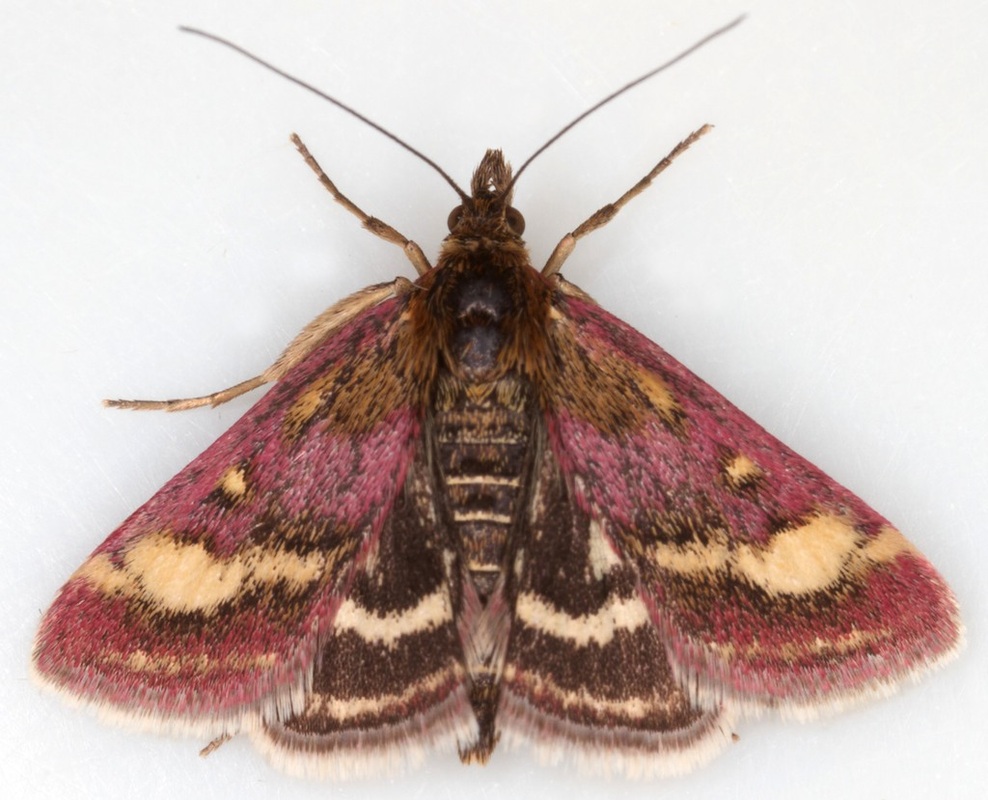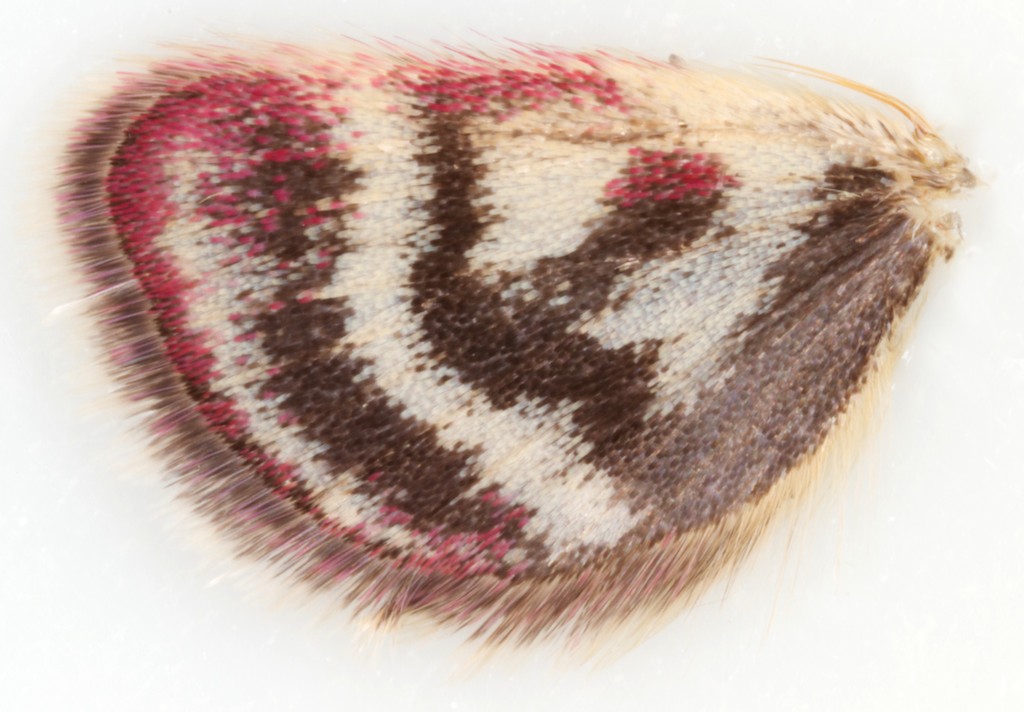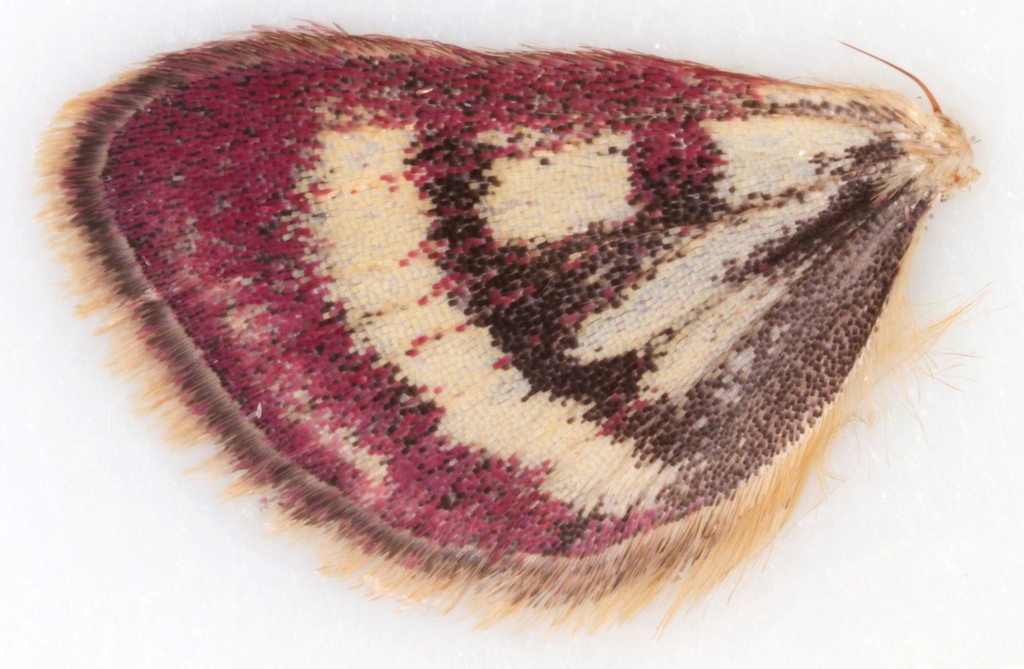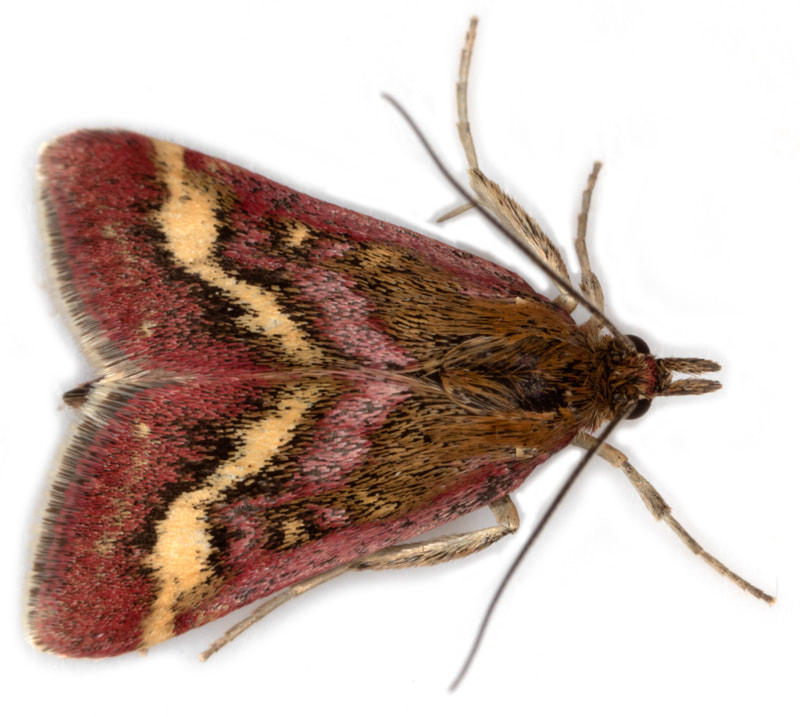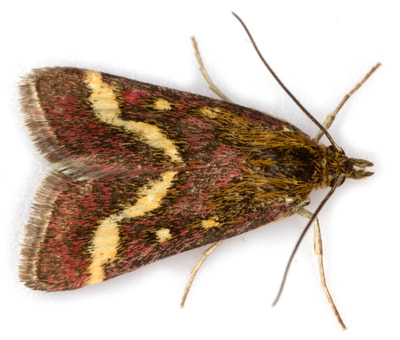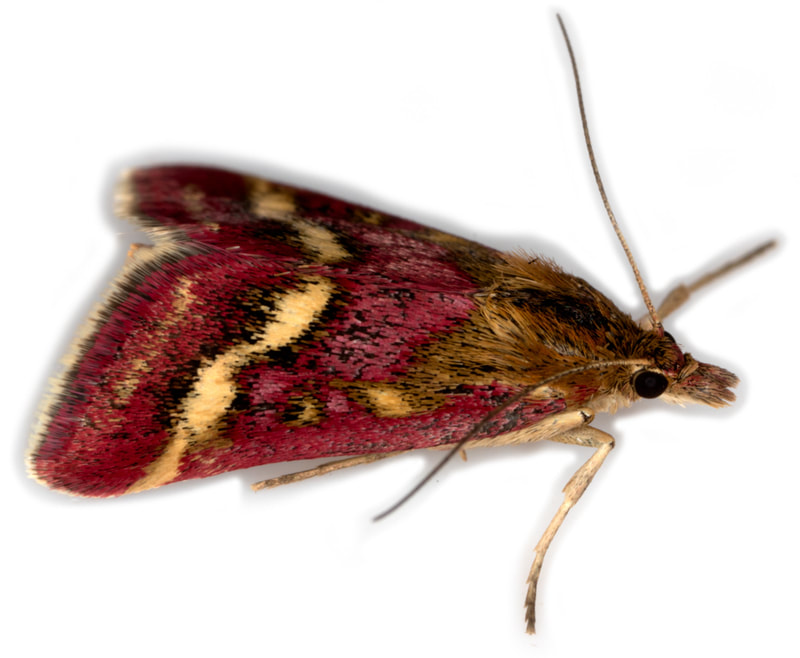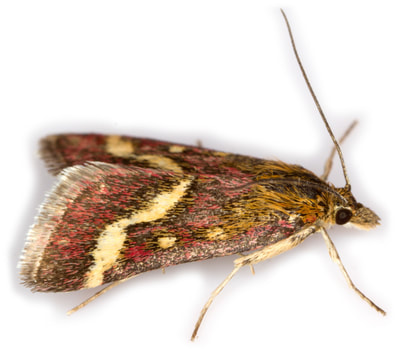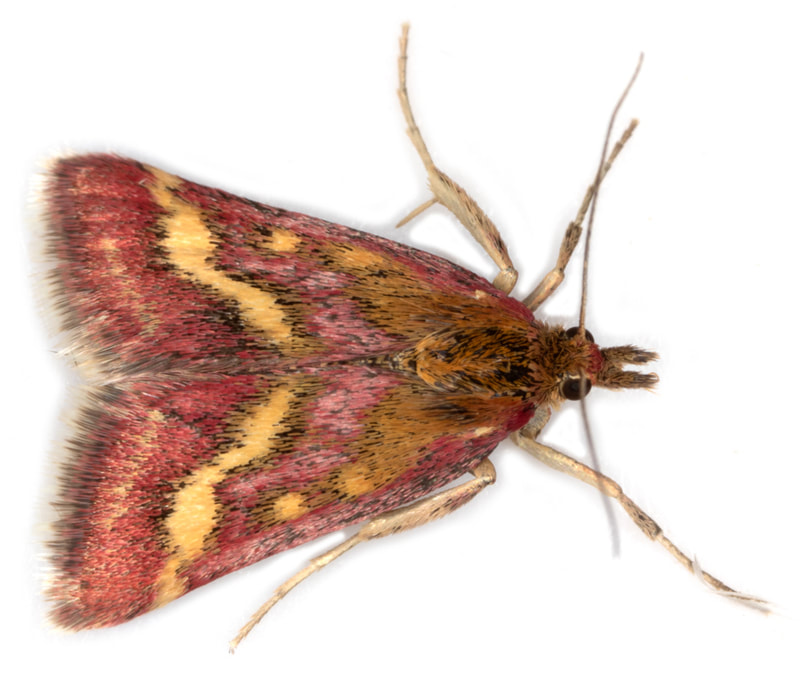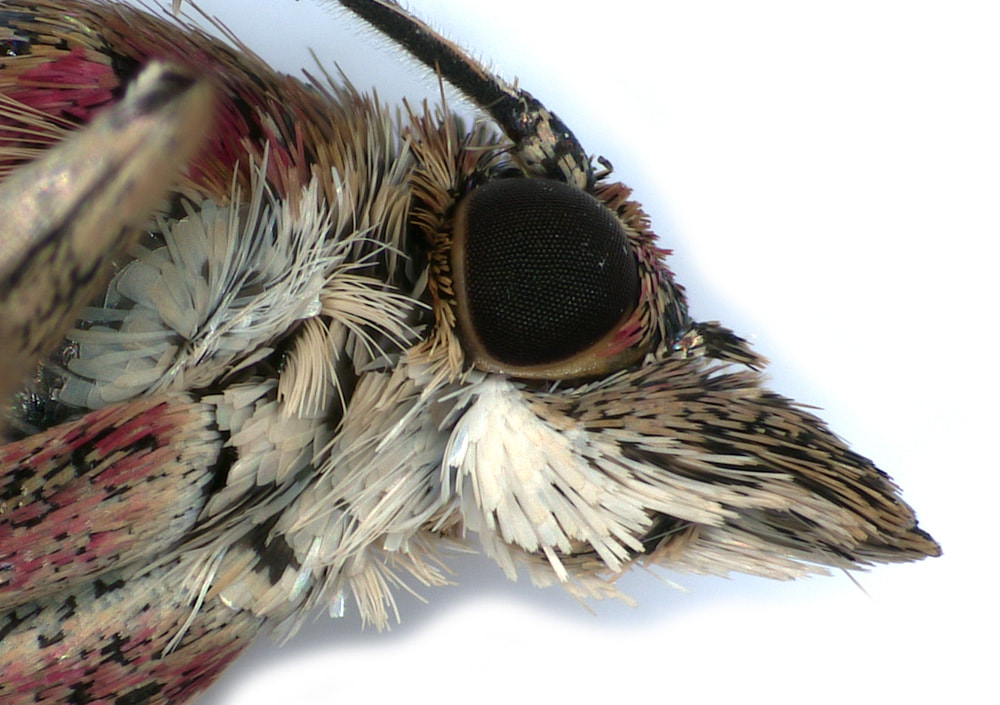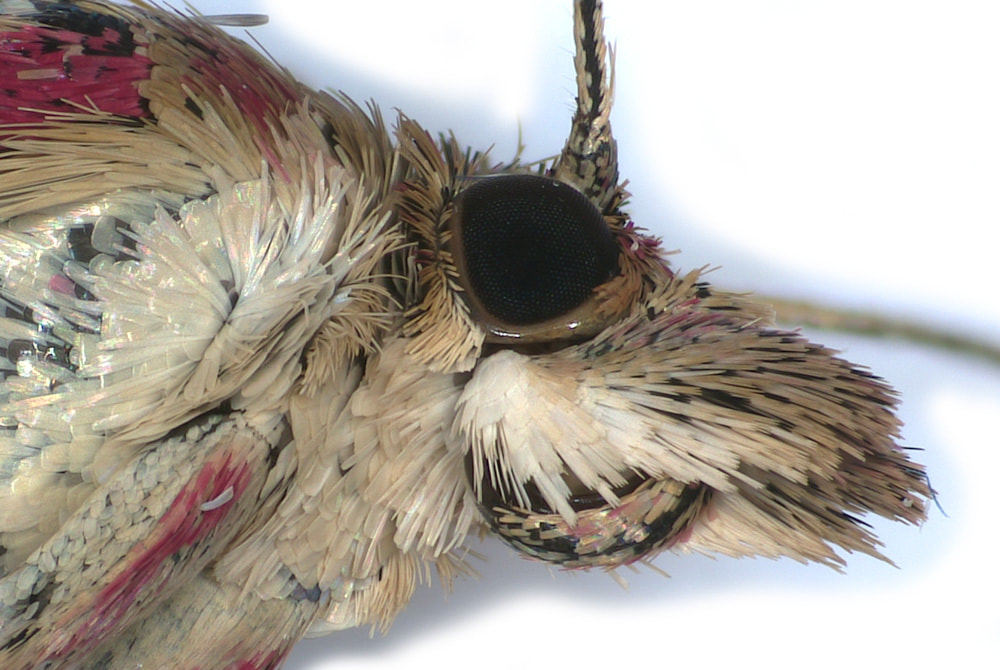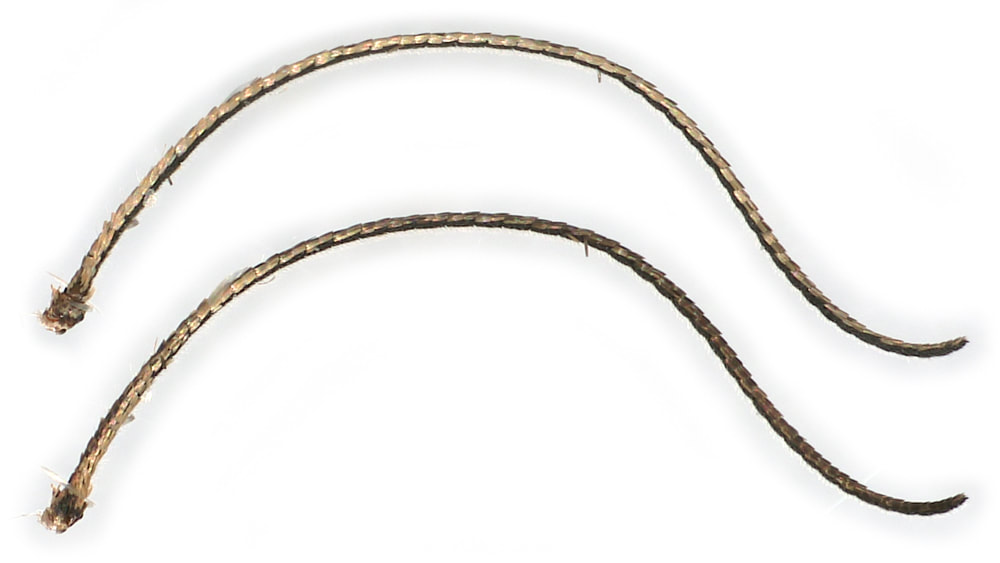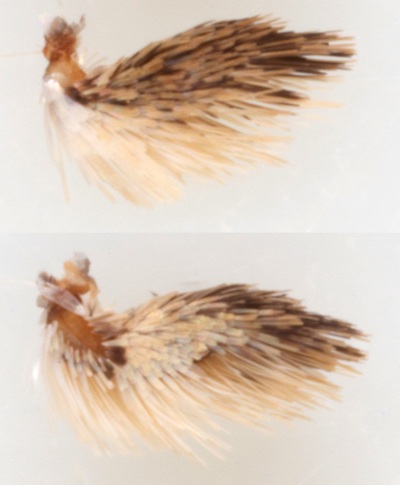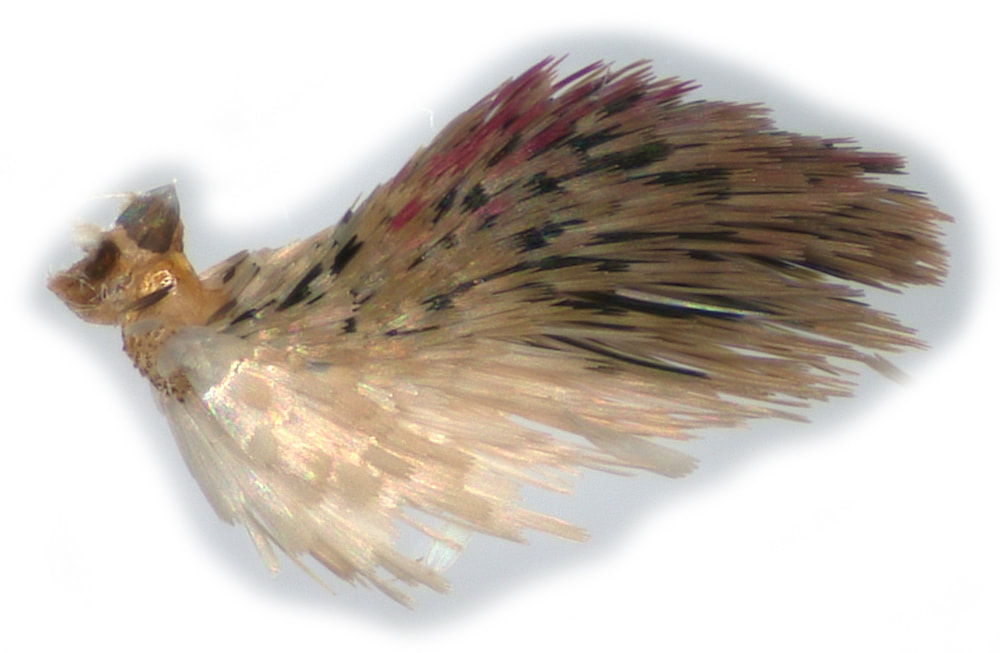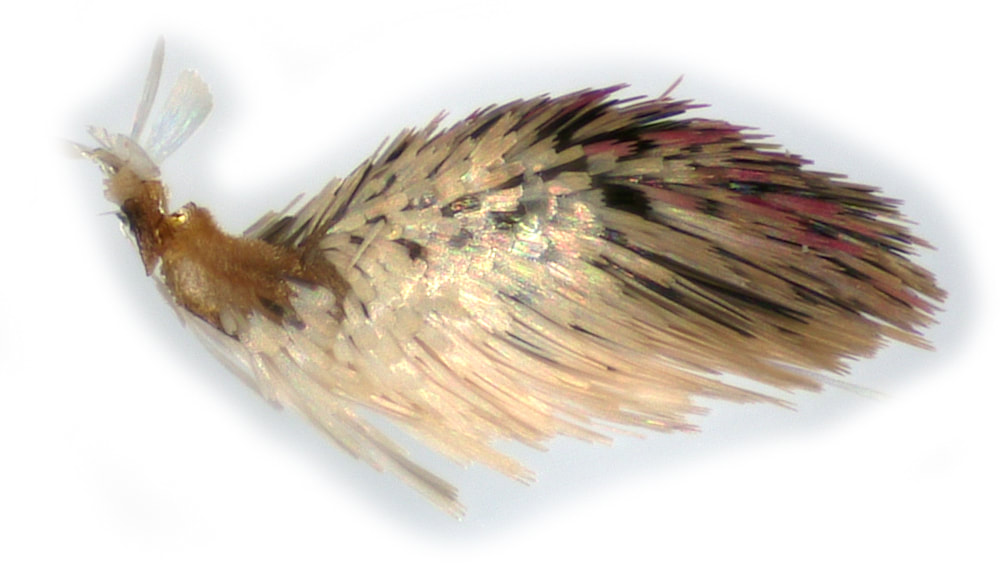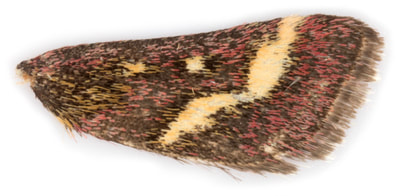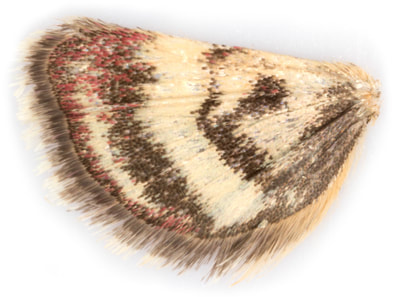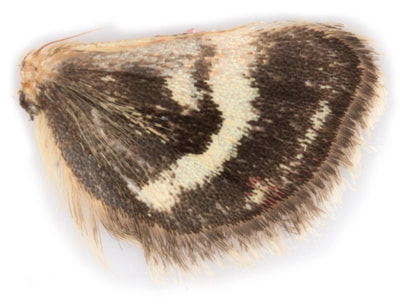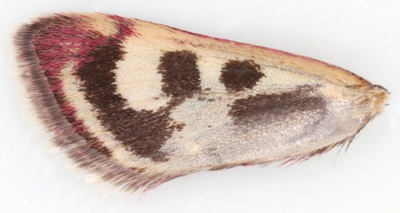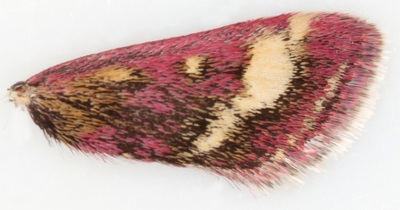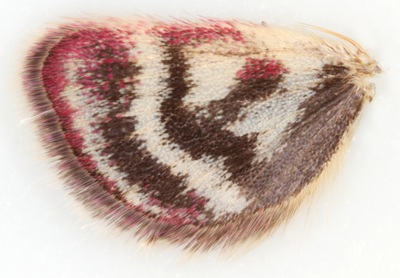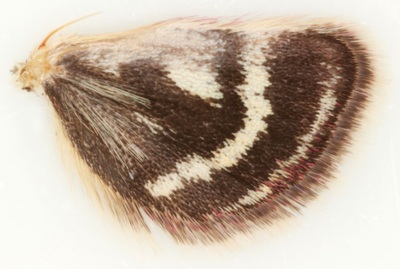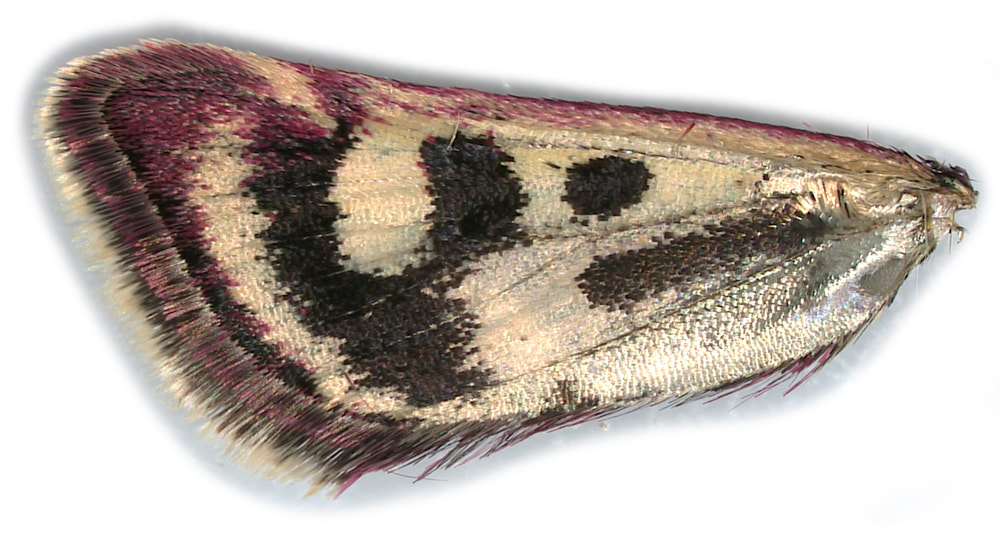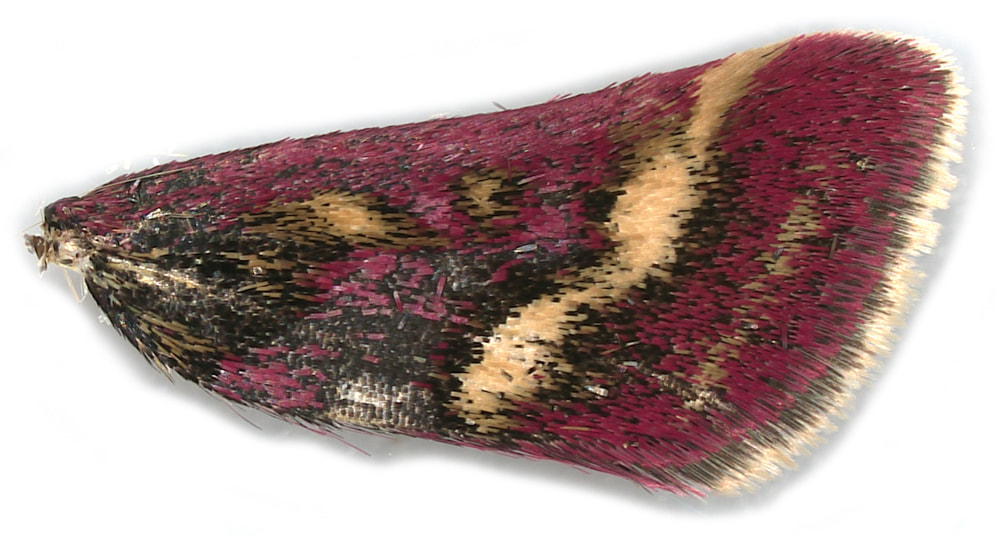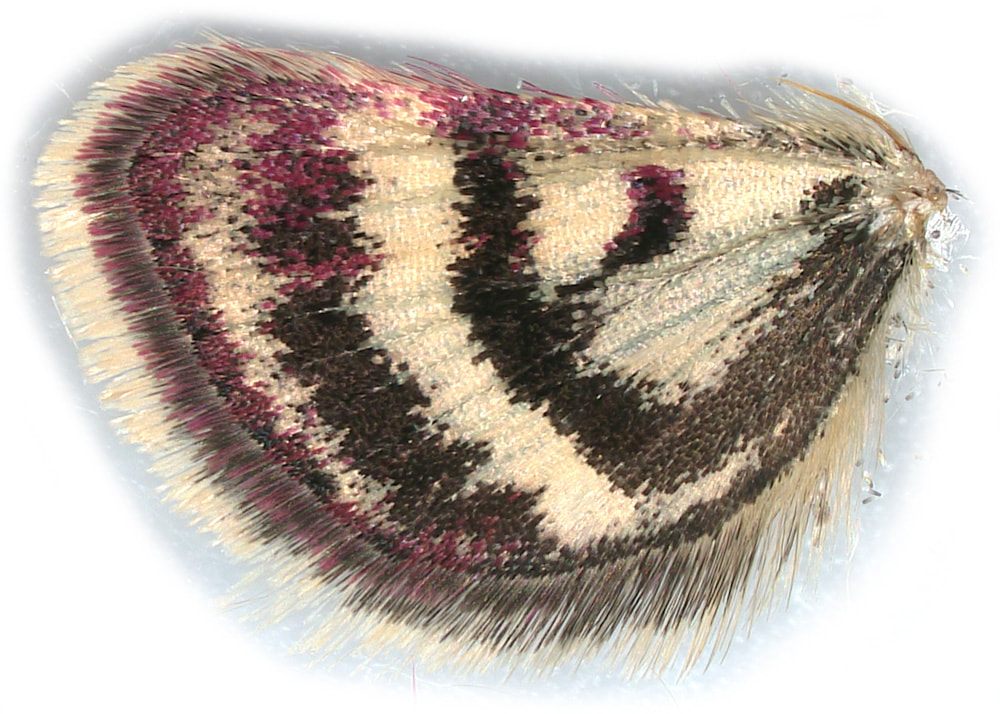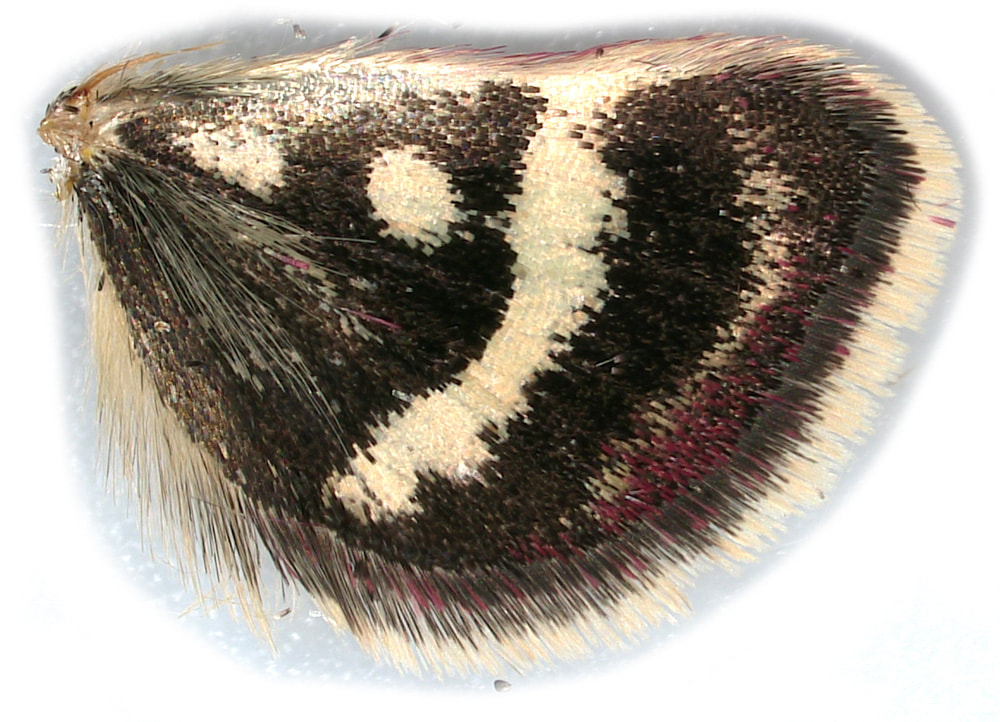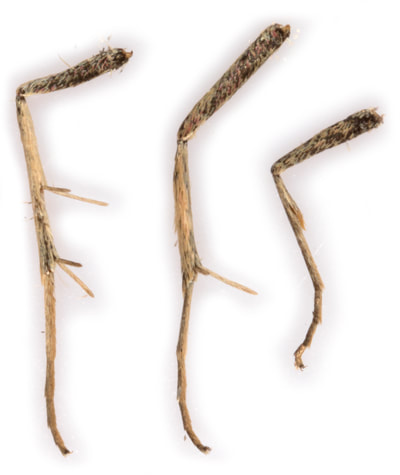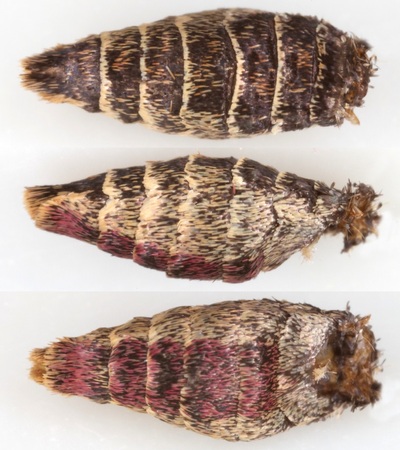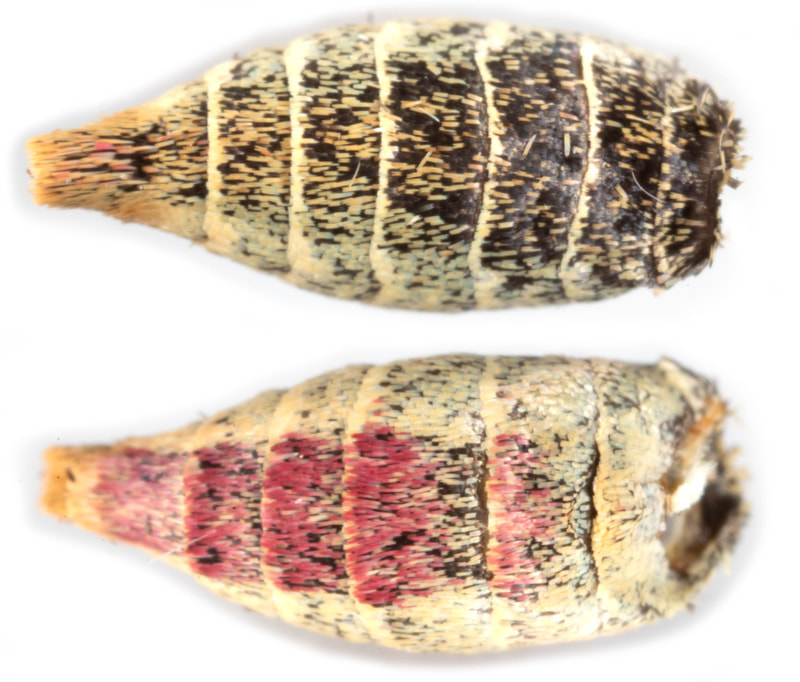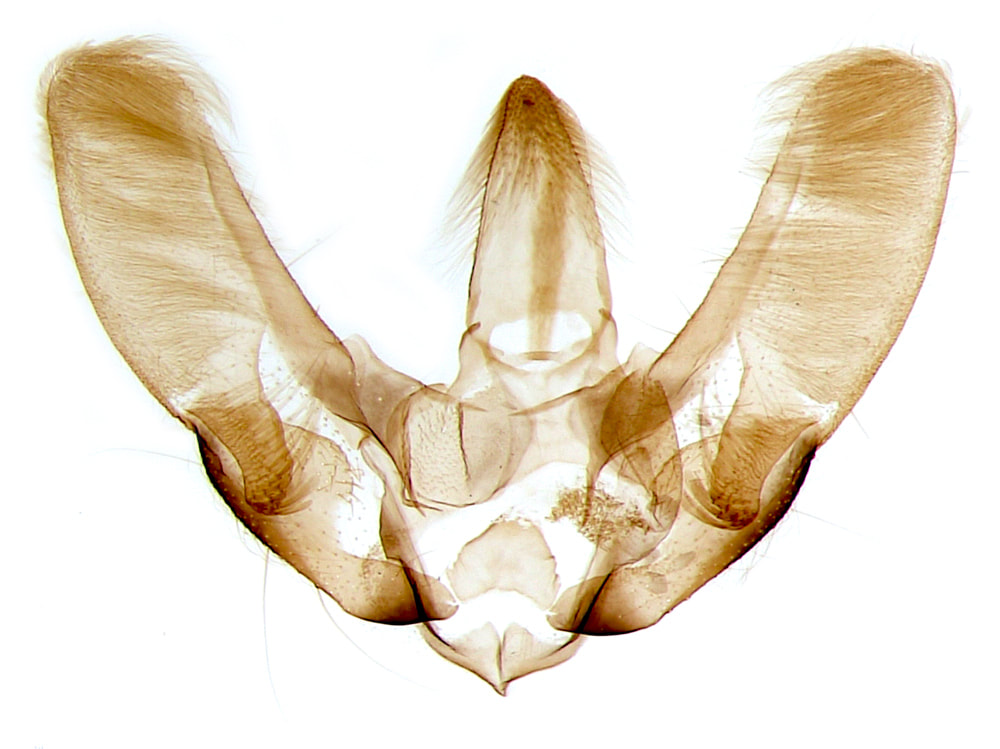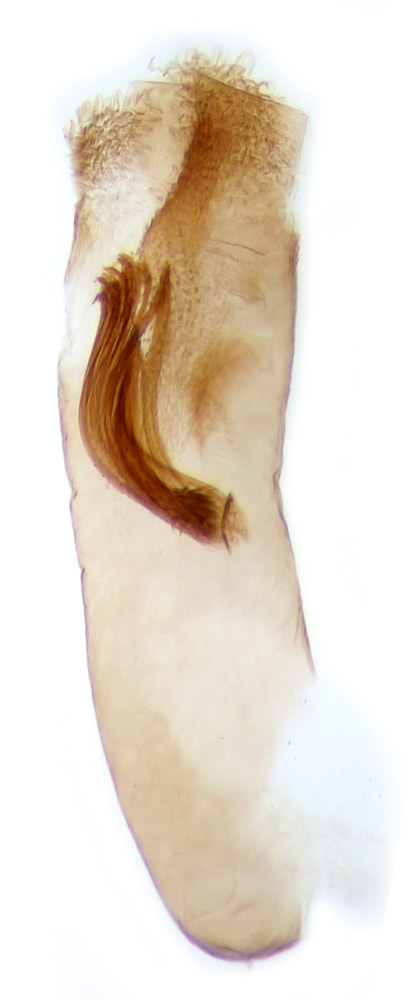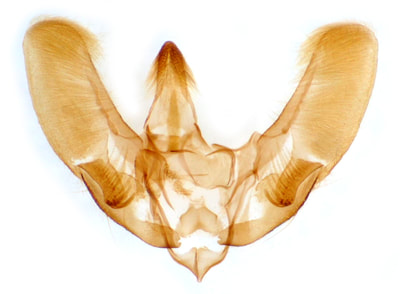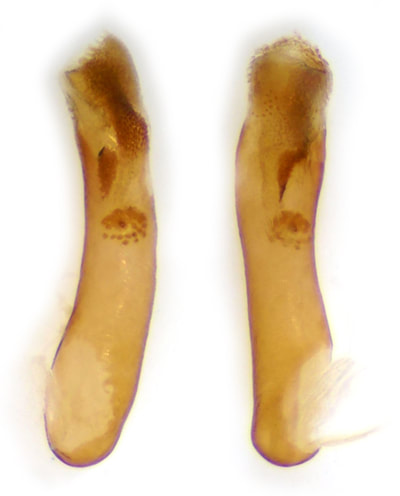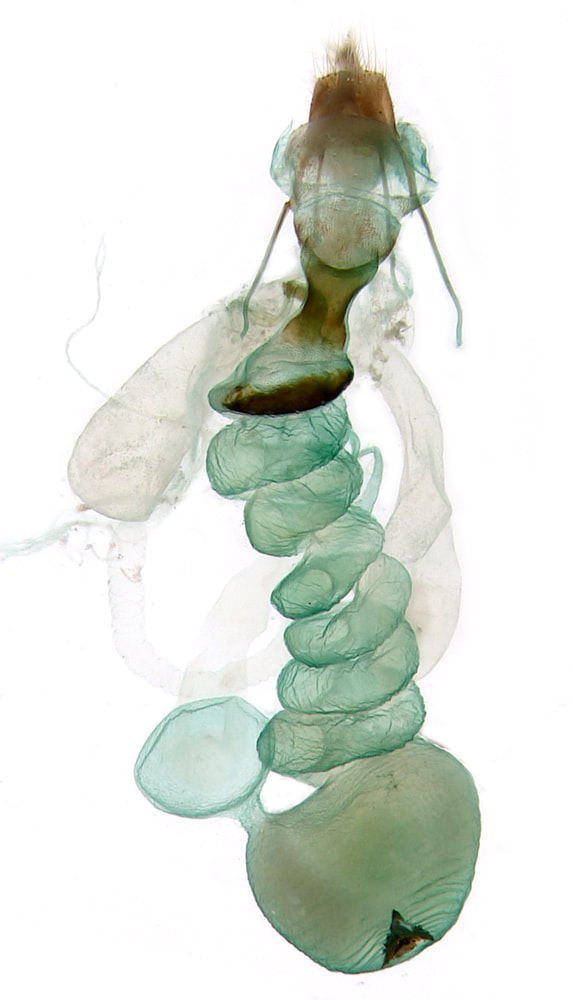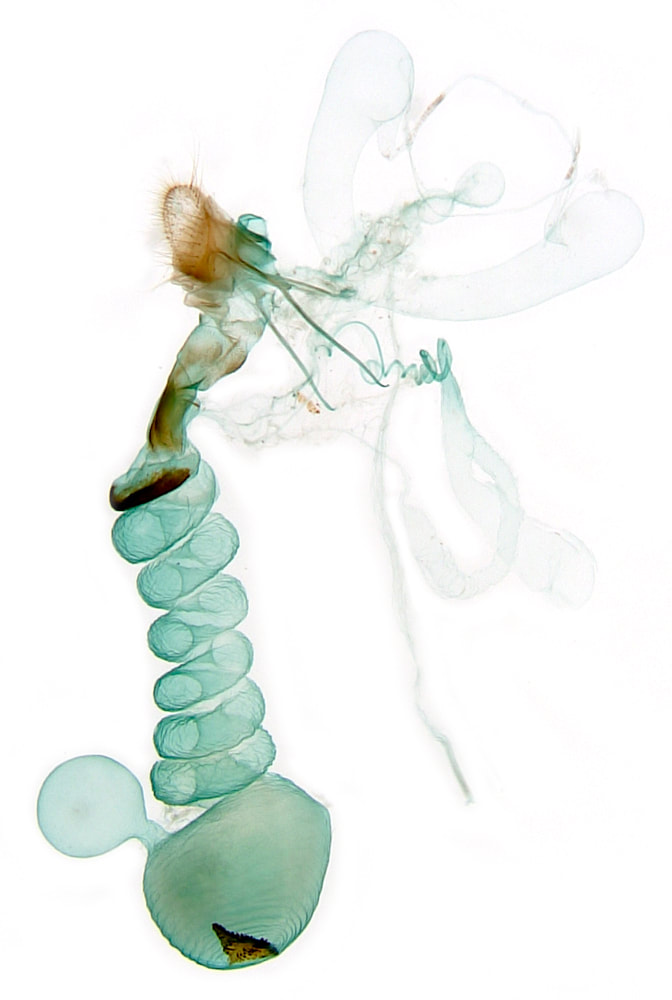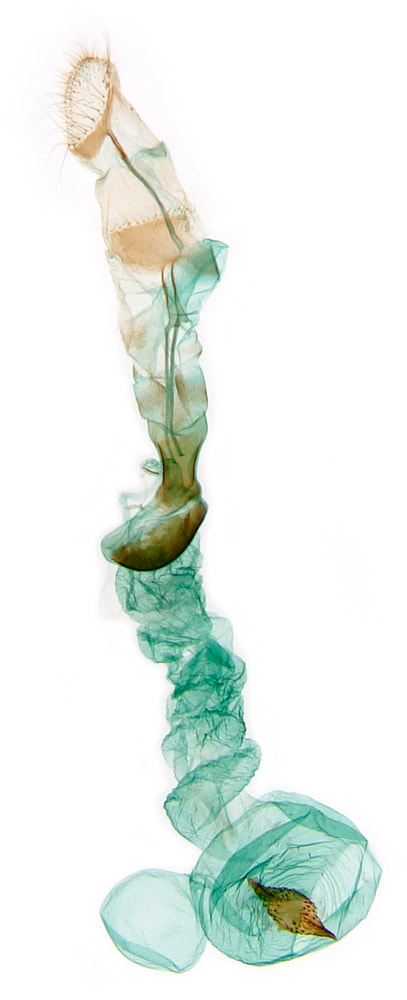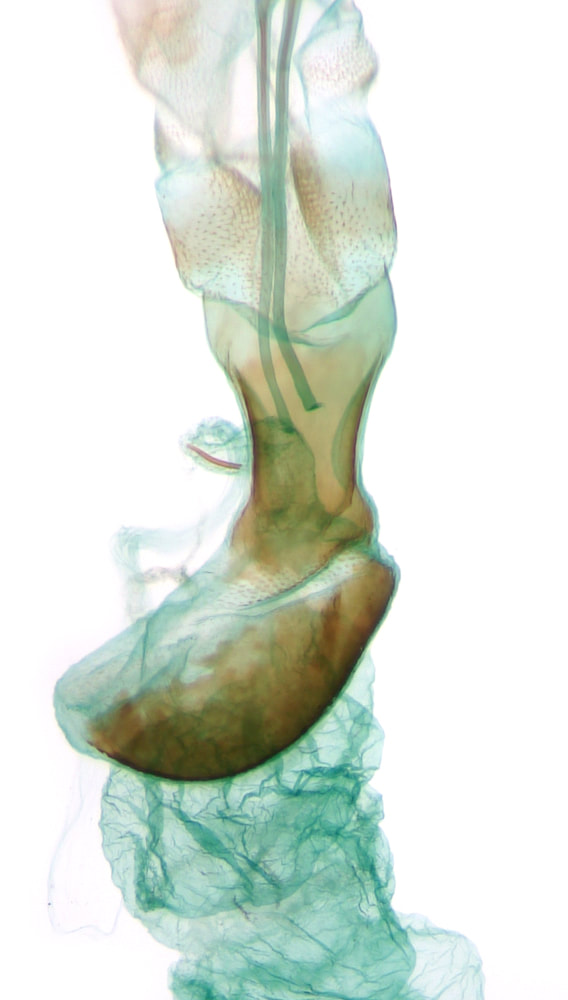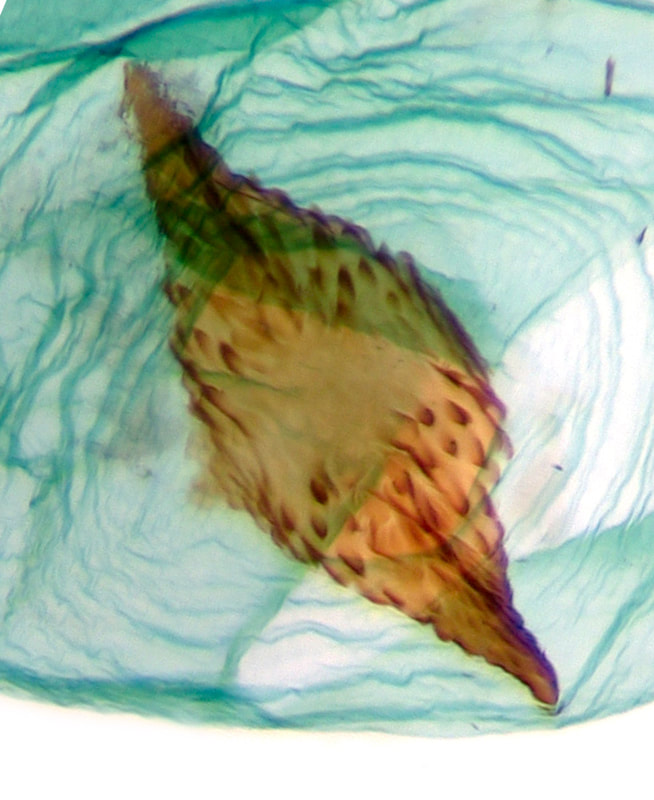63.008 Pyrausta ostrinalis (Scarce Purple-and-gold)
ws:15-21mm; bivoltine May-Jun, Jul-Aug; corn mint (Mentha arvensis), wild thyme (Thymus polytrichus); local in dry grassland and chalk downs throughout GB
ID: Similar to P.aurata and P.purpuralis. When compared to fresh P.aurata/purpuralis, P.ostrinalis has paler yellower markings; however the markings of P.aurata/purpuralis fade from golden to yellow or whitish with wear. On the forewing upperside, according to Goater, the markings of P.ostrinalis are similar to those of P.purpuralis. Both P.purpuralis and P.ostrinalis show a narrow subterminal yellow line which is (always?) lacking in P.aurata. According to UKMoths: In P.aurata the only consistent postmedian mark is a round golden blotch near the costa (subcostal blotch) and there is usually a small golden mark between it and the costa (costal blotch); marks between the subcostal blotch and the dorsum are variable. In P.purpuralis and P.ostrinalis the postmedian markings may form a continuous band from costa to dorsum, but in P.purpuralis this band is more often broken into 3 substantial marks. Both Goater and Hants Moths describe a blackish suffusion or edging around the postmedian yellow band in P.ostrinalis which seems not to be shown by P.purpuralis. All references report the forewing of P.ostrinalis to be narrower than that of P.purpuralis, but none tell us how we are to determine this and I have been unable to come up with any useful distinction based on wing ratios.
On the hindwing upperside all three species show a curved yellow postmedian line. P.purpuralis and P.ostrinalis also show variable basal markings, while P.aurata shows none.
Goater gives a more absolute distinction between P.purpuralis and P.ostrinalis based on the underside: "the pale subterminal line in P.purpuralis is nearly straight and fades before the costa, whereas in P.ostrinalis it curves to meet the postmedian line at the costa". We are left to infer that he is talking about the forewing. In the drawings in Goater that are supposed to illustrate this difference, the curved subterminal line of P.ostrinalis does reach the costa but does not meet the postmedian line. No web image labelled as P.ostrinalis shows this subterminal line either reaching the costa or the postmedian line. A more obvious difference on the forewing underside seems to be in the proportions of blackish and whitish colour - in P.purpuralis there is more blackish so that there appear to be 3 pale subcostal spots while in P.ostrinalis there is more whitish so that there appear to be 2 black subcostal spots. (The drawings in Sterling & Parsons and my images illustrate this nicely).
The differences in the hindwing underside (see images below) seem to provide the most objective separation of P.ostrinalis/purpuralis:
1. The postmedian pale line reaches the costa in P.ostrinalis, but in P.purpuralis there is a broad purple costal streak which separates the costal end of the postemdian line from the costa. This difference is mentioned as the key difference between the species in Sterling and Parsons, is illustrated but not mentioned in Goater and is clear from comparing my images of the two species.
2. The subterminal pale line is distinct and runs most of the length of the termen in P.ostrinalis; more obscure and shorter in P.purpuralis.
3. The ground colour between the postmedian and subterminal pale lines is mostly black in P.ostrinalis and almost entirely purple in P.purpuralis.
(2. & 3. are based on my own observations, comparing textbook illustrations and web images - but I have not seen these differences mentioned elsewhere and they will be subject to further testing).
Goater states that the hindwing cilia of P.aurata are white while those of P.purpuralis and P.ostrinalis have a dark fuscous basal half and a greyish white apical half - this does not seem to provide a valid distinction between the species.
On the hindwing upperside all three species show a curved yellow postmedian line. P.purpuralis and P.ostrinalis also show variable basal markings, while P.aurata shows none.
Goater gives a more absolute distinction between P.purpuralis and P.ostrinalis based on the underside: "the pale subterminal line in P.purpuralis is nearly straight and fades before the costa, whereas in P.ostrinalis it curves to meet the postmedian line at the costa". We are left to infer that he is talking about the forewing. In the drawings in Goater that are supposed to illustrate this difference, the curved subterminal line of P.ostrinalis does reach the costa but does not meet the postmedian line. No web image labelled as P.ostrinalis shows this subterminal line either reaching the costa or the postmedian line. A more obvious difference on the forewing underside seems to be in the proportions of blackish and whitish colour - in P.purpuralis there is more blackish so that there appear to be 3 pale subcostal spots while in P.ostrinalis there is more whitish so that there appear to be 2 black subcostal spots. (The drawings in Sterling & Parsons and my images illustrate this nicely).
The differences in the hindwing underside (see images below) seem to provide the most objective separation of P.ostrinalis/purpuralis:
1. The postmedian pale line reaches the costa in P.ostrinalis, but in P.purpuralis there is a broad purple costal streak which separates the costal end of the postemdian line from the costa. This difference is mentioned as the key difference between the species in Sterling and Parsons, is illustrated but not mentioned in Goater and is clear from comparing my images of the two species.
2. The subterminal pale line is distinct and runs most of the length of the termen in P.ostrinalis; more obscure and shorter in P.purpuralis.
3. The ground colour between the postmedian and subterminal pale lines is mostly black in P.ostrinalis and almost entirely purple in P.purpuralis.
(2. & 3. are based on my own observations, comparing textbook illustrations and web images - but I have not seen these differences mentioned elsewhere and they will be subject to further testing).
Goater states that the hindwing cilia of P.aurata are white while those of P.purpuralis and P.ostrinalis have a dark fuscous basal half and a greyish white apical half - this does not seem to provide a valid distinction between the species.
Male genitalia: dissection group gives images for all three species but I have not seen descriptions. Differences between P.purpuralis and P.aurata noted by comparing images are as follows, features for P.aurata are given first: 1, Uncus - fairly clearly demarcated from tegumen, narrow, elongate ~3x longer than broad, parallel to just before an apical point vs not clearly demarcated, broad, gradually narrowing to a rounded apex; 2. Margin of vinculum between apex (saccus?) and ventral margin of valva: concave vs convex (though this could be an artefact); 3. Structure sited on the surface of the valva in its proximal half the name of which I do not know: isosceles triangular with a short side distally, pointed basally vs even width, bluntly quadrangular. Goater states that differences between the genitalia of P.purpuralis and P.ostrinalis are slight but comparison of images suggests that P.ostrinalis is intermediate between P.purpuralis and P.aurata
Female genitalia: differences appear in the shape of the signum and in the sclerotisation of the introitus vaginae/posterior ductus bursae as shown in the images at Dissection Group of P.aurata/purpuralis/ostrinalis, but at this time I am uncertain whether these differences are real or artefactual.
Female genitalia: differences appear in the shape of the signum and in the sclerotisation of the introitus vaginae/posterior ductus bursae as shown in the images at Dissection Group of P.aurata/purpuralis/ostrinalis, but at this time I am uncertain whether these differences are real or artefactual.
§1 Tennyson Down, Isle of Wight; 01/06/2014; fw 7.7mm
§2 Knipe Scar, Cumbria; 14/06/2017; male; fw 7.4mm; netted by day
§3 Warton Crags, Lancashire; 18/05/2021; female; fw 8.2mm; netted by day
§4 Warton Crags, Lancashire; 18/05/2021; male; fw 8.3mm; netted by day
§5 Meall Garbh, Perthshire; 16/06/2021; netted by day
All images © Chris Lewis
§2 Knipe Scar, Cumbria; 14/06/2017; male; fw 7.4mm; netted by day
§3 Warton Crags, Lancashire; 18/05/2021; female; fw 8.2mm; netted by day
§4 Warton Crags, Lancashire; 18/05/2021; male; fw 8.3mm; netted by day
§5 Meall Garbh, Perthshire; 16/06/2021; netted by day
All images © Chris Lewis
Page published 17/06/2014 (§1) | §2 added 15/03/2018 | §3&4 added 05/06/2021 | §5 added 10/10/2021
